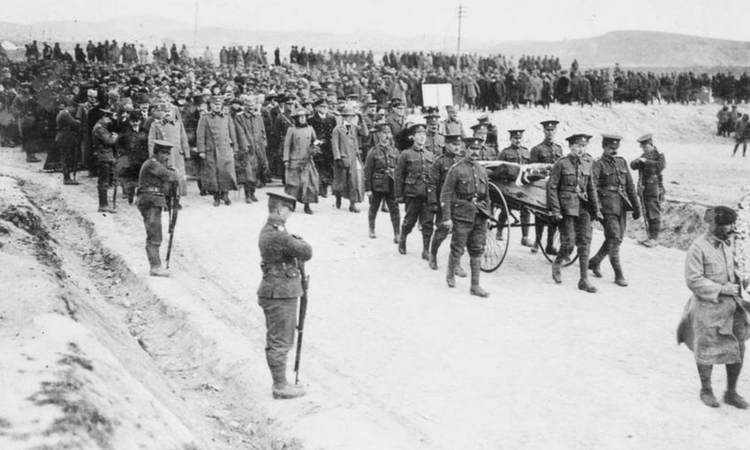06 February 2018
CWGC remembers women who fought for the right to vote
The CWGC commemorates more than 650 woman who died during the First World War. Nurses, munitions factory workers, postal service and police patrols were some of the most common jobs for women during the war. Many women also supported and campaigned as part of the suffragette movement, which after years of struggle saw the first British women gain the right to vote in February 1918. Here are two women remembered at CWGC sites who supported the movement 100 years ago.

Funeral procession of Mrs. Harley (sister of Lord French) who was killed by a shell at Monastir, Salonika, March 1917. © IWM (Q 32782)
Katherine Harley
Among more than 1,600 graves in the CWGC’s Salonika (Lembet Road) Military Cemetery is an unusual memorial to Katherine Mary Harley.
The grave, marked by a large stone cross, bears a moving  inscription chosen by Officers and men of the Serbian Army. The sister of Field Marshal Sir John French, Commander in Chief of the British Expeditionary Force in France and Flanders in 1914-1915, Katherine led a group of British nurses serving with the Serbian Army until her death in 1917. The inscription reads:
inscription chosen by Officers and men of the Serbian Army. The sister of Field Marshal Sir John French, Commander in Chief of the British Expeditionary Force in France and Flanders in 1914-1915, Katherine led a group of British nurses serving with the Serbian Army until her death in 1917. The inscription reads:
“On your tomb instead of flowers the gratitude of the Serbs shall blossom there. For your wonderful acts your name shall be known from generation to generation.”
Katherine Harley was born in Kent on 3 May 1855.
Before the First World War, Katherine was a prominent member of the suffragist movement. At the age of 61 when war broke out in 1914, she volunteered to put her nursing background to good use – initially serving in France, where she was awarded the Croix de Guerre.
By late 1915 Katherine was in Greece – where she established and commanded a motorised ambulance unit. The unit operated near the frontline – collecting Serbian casualties and bringing them to one of the many hospitals for treatment.
Keeping the vehicles roadworthy was no easy task in this harsh climate. The unit also had a reputation for ignoring orders in their enthusiasm to help the wounded – even operating at night, close to the battlefield, despite explicit orders not to do so.
When the town of Monastir (now Bitola) was captured, Katherine decided to rent a house there so that she could provide assistance to the town’s inhabitants, despite the fact the town was still on the frontline and within easy range of artillery.
On 7 March 1917 Katherine was with her daughter and Miss  Mary L. Matthews, head of the American Girls' School, when a shell landed nearby and killed her.
Mary L. Matthews, head of the American Girls' School, when a shell landed nearby and killed her.
Since at the time of her death she was a civilian working for the Serbian forces, she did not “qualify” for military commemoration but her funeral was attended by Prince George of Serbia, General Milne, the commander of the British forces, and many other dignitaries, and was accompanied by contingents of troops and military bands.
Staff Nurse Mary Rodwell
Mary Ann Rodwell was a member of the Queen Alexandra’s  Imperial Military Nursing Service.
Imperial Military Nursing Service.
She trained at Hendon Infirmary Hospital in North West London, later working at Samaritan Free Hospital, London, and in private nursing homes. When war broke out she felt it her duty to volunteer for overseas service, and was on hospital trains before moving to the Hospital Ship Anglia.
She died on 17 November 1915 when Anglia hit a mine laid by a German U boat, and sunk.
Some of the men on the ship reported Sister Rodwell had been injured in the initial explosion. They said she was on the deck with the Matron and was urged to get into a boat which had come alongside, but would not hear of it saying “we have the right to be last this time”.
Mary’s colleagues who survived said they could not speak too highly of her.
Mary was recorded as being an enthusiastic suffragist and "ardent" supporter of the Crystal Palace and Anerley Women's Freedom League (WFL). She became involved in the local branch while living with her aunt and uncle in South London.
After her death, the Crystal Palace and Anerley Women's Freedom League stated that Mary Rodwell's “name will be held in honour and reverence”.
An obituary in the Norwood News in December 1915, stated: “So far as we know she is the first member of the Women’s Freedom League to sacrifice her life on active service…..She was a member of the Crystal Palace and Anerley branch of the Women’s Freedom League and her name will be held in honour and reverence by the whole league.”
She is commemorated on the Hollybrook Memorial in Southampton.
Photo credits: Mrs Catherine Mary Harley, Serbian Relief Fund. Killed by Bulgarian shellfire at Monastir 07 March 1917. © IWM (WWC R27-2-1)
Staff Nurse Mary Rodwell, Queen Alexandra's Imperial Military Nursing Service Reserve. Drowned when the Hospital Ship Anglia was mined in the English Channel, 17 November 1915. © IWM (WWC H21-23)

